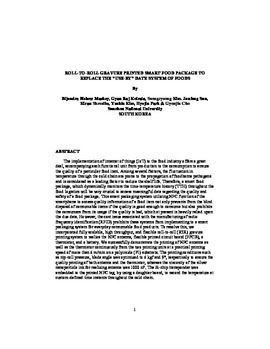| dc.contributor.author | Maskey, Bijendra Bishow | |
| dc.contributor.author | Koirala, Gyan Raj | |
| dc.contributor.author | Kim, Seongryeong | |
| dc.contributor.author | Sun, Junfeng | |
| dc.contributor.author | Shrestha, Kiran | |
| dc.contributor.author | Kim, Yushin | |
| dc.contributor.author | Park, Hyejin | |
| dc.contributor.author | Cho, Gyoujin | |
| dc.contributor.other | International Conference on Web Handling (2019) | |
| dc.date.accessioned | 2019-06-04T16:16:36Z | |
| dc.date.available | 2019-06-04T16:16:36Z | |
| dc.date.issued | 2019-06 | |
| dc.identifier | oksd_icwh_2019_maskey2 | |
| dc.identifier.citation | Maskey, B. B., Koirala, G. R., Kim, S., Sun, J., Shrestha, K., Kim, Y., Park, H., & Cho, G. (2019, June). Roll-to-roll gravure printed smart food package to replace the "use-by" date system of foods. Paper presented at the Fifteenth International Conference on Web Handling (IWEB), Stillwater, OK. | |
| dc.identifier.uri | https://hdl.handle.net/11244/320262 | |
| dc.description.abstract | The implementation of internet of things (IoT) to the food industry offers a great deal, accompanying each functional unit from production to the consumption to ensure the quality of a particular food item. Among several factors, the fluctuation in temperature through the cold chain are prone to the propagation of foodborne pathogens and is considered as a leading factor to reduce the shelf life. Therefore, a smart food package, which dynamically monitors the time-temperature history (TTH) throughout the food logistics will be very crucial to access meaningful data regarding the quality and safety of a food package. This smart packaging system utilizing NFC function of the smartphone to access quality information of a food item not only prevents from the blind disposal of consumable items if the quality is good enough to consume but also prohibits the consumers from its usage if the quality is bad, which at present is heavily relied upon the due date. However, the cost issue associated with the manufacturing of radio frequency identification (RFID) prohibits these systems from implementing to a smart packaging system for everyday consumable food products. To resolve this, we incorporated fully scalable, high throughput, and flexible roll-to-roll (R2R) gravure printing system to realize the NFC antenna, flexible printed circuit board (FPCB), a thermistor, and a battery. We successfully demonstrate the printing of NFC antenna as well as the thermistor continuously from the two printing units at a practical printing speed of more than 6 m/min on a polyimide (PI) substrate. The printing conditions such as nip-roll pressure, blade angle was optimized to 6 kgf and 9°, respectively to ensure the quality printing of both antenna and the thermistor, whereas the viscosity of the silver nanoparticle ink for realizing antenna was 1000 cP. The Si-chip transponder was embedded to the printed NFC tag, by using a daughter board, to record the temperature at custom-defined time instants throughout the cold chain. | |
| dc.format | application/pdf | |
| dc.language | en_US | |
| dc.publisher | Oklahoma State University | |
| dc.rights | In the Oklahoma State University Library's institutional repository this paper is made available through the open access principles and the terms of agreement/consent between the author(s) and the publisher. The permission policy on the use, reproduction or distribution of the article falls under fair use for educational, scholarship, and research purposes. Contact Digital Resources and Discovery Services at lib-dls@okstate.edu or 405-744-9161 for further information. | |
| dc.title | Roll-to-roll gravure printed smart food package to replace the "use-by" date system of foods | |
| osu.filename | oksd_icwh_2019_maskey2.pdf | |
| dc.type.genre | Conference proceedings | |
| dc.type.material | Text | |
